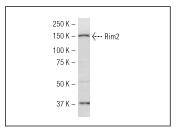Rab3, a neural/neuroendocrine-specific member of the Rab family, is involved in Ca2+-regulated exocytosis. Rab3 functions in an inhibitory capacity by controlling the recruitment of secretory vesicles into a releasable pool at the plasma membrane. Rim (rab3 interacting molecule), a putative effector protein for Rab3s, is composed of an N-terminal zinc-finger motif and C-terminal PDZ and C2 domains. Rim exists as two variants, Rim1 and Rim2, produced by alternative splicing. The 3-end of the Rim2 gene produces an independent mRNA that encodes a smaller protein referred to as Nim2, which like Rim, also regulates exocytosis. Rim serves as a Rab3-dependent regulator of synaptic-vesicle fusion by forming a GTP-dependent complex between synaptic plasma membranes and docked synaptic vesicles. Both Rim1 and Rim2 can bind to cAMP-GEFII, which is a direct target of cAMP in regulated exocytosis and is responsible for cAMP-dependent, PKA-dependent exocytosis. Rim also localizes on the plasma membrane of INS-1E cells and pancreatic beta-cells. Rab3 binding domain of Rim enhances glucose-stimulated secretion in intact cells and Ca2+-stimulated exocytosis in permeabilized cells, suggesting that Rim may also play a regulatory role in insulin secretion.

